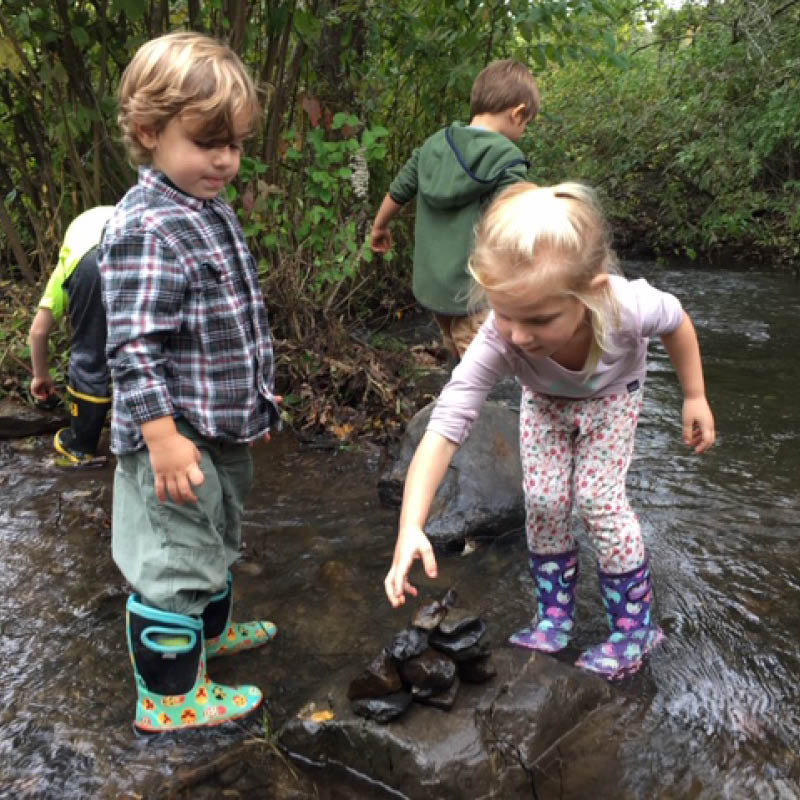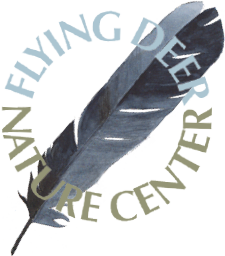Here are a few ways to tap into the power of nature connection to support joy and learning for little ones.
Storytelling
Learn one or two stories a week to tell your child orally. This can be shared during snack or rest time. Here are a few resources for stories:
- The Natural Storyteller by Georgiana Keable (I love this book!)
- Circle Round podcast (created and run by Flying Deer parents!)
Sit Spot
Find a sit spot in your yard (or inside near a window if you don’t have easy access to outdoors) and return to it at least twice a week. When we find spots in Forest K, we first wake up our Deer Ears, Bear Noses, Owl Eyes, and Raccoon Fingers to activate our senses. Then we quiet our minds together by taking some deep breaths, and then slowly walk away, letting our hearts lead the way to the spot that is the right fit for each person. As a general rule, we start out doing a sit spot for the same amount of minutes as the age of the child (5 years old = 5 minutes); however, I have seen children that young go for 10–15 minutes.
After the sit spot time is over, we gather again to share what we noticed. Some good questions for this are: What did you hear? See? Smell? Which direction was the wind/ bird song coming from? What did you body feel like? Were you calm? Energized? Name one magical thing you saw. Tell me a story about what was happening around you.
Naturalist Skill
Walk around your yard, nearby forest, or park and find maple trees. See if you can identify and find differences between different kinds of maple trees (e.g. red maple, sugar maple). Encourage your children to use their sense: what does the bark feel like? What shapes are in the trees, do they see any patterns?

If you feel called to and have the time, tap a tree to collect sap. Ask the tree first if it is okay! Drill a hole and put in a spile. Collect using buckets or gallon jugs. Spiles can be made using sumac trees. Here’s a simple example.
Once you have several gallons of sap, you can start simmering it. You can do this over a regular stove or wood stove. For larger amounts, creating an evaporating system and using firewood is better. Keep an eye on it as it will take a long time to boil down, but will become syrup very quickly! You need 40 gallons of sap to make 1 gallon of syrup.
If you have already tapped trees, you can start to look at birds and bird language. You can direct your child to look more specifically at birds during their sit spot and then talk about which ones you saw. Binoculars are a handy tool. Come up with fun mnemonics for the bird songs you hear. If you need some help here is a great resource: http://www.fernbank.edu/Birding/mnemonics.htm
Cultural Skill
Have a conversation around germs and how staying clean helps everyone. Here is a really cool and simple experiment you can do!
Pull out old photos of your family if you have them and share with your children things that you grew up doing. Choose one thing you might like to do more together and try it out!
Craft
Make a journal documenting a change in nature during the spring awakening. You can take a picture or draw a picture every day of a bud on a tree, a patch of grass, a flower or cattail shoot. If you’re mostly indoors, consider drawing leaves of your house plants, watching for changes in how they behave (leaning toward the sun, for example). Or use books as models for drawing.
Tending the Land
Now is a good time to harvest some willow shoots to replant if you wish to propagate them. You can simply cut some shoots and let them sit in a mason jar for a week or until they start to root. Once they have significant roots on them you can plant them directly in the ground in wet soil. Willow is a wonderful plant to have around. It can be used for basketry, medicine and can be redirected as it grows to create amazing natural structures.
In connection,
Julie (Red Fox) & JJ
